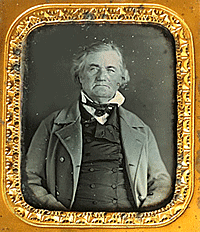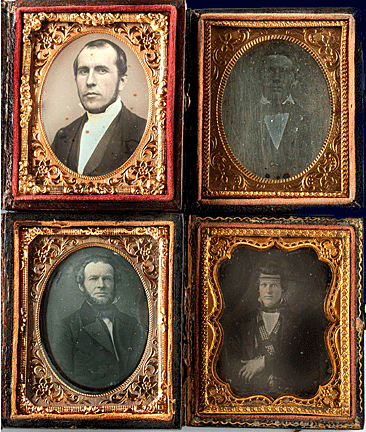|
The First Photographic Prints
by Bob Brooke
 One
of the most common antique photographic items seen in antique shops and
shows is the daguerreotype. Often these are small portraits of Victorian
men and women set behind glass in elaborate wooden frames. These little
daguerreotypes represent the beginnings of a technology that’s common
today. One
of the most common antique photographic items seen in antique shops and
shows is the daguerreotype. Often these are small portraits of Victorian
men and women set behind glass in elaborate wooden frames. These little
daguerreotypes represent the beginnings of a technology that’s common
today.
The daguerreotype, widely used during the 1840s and 1850s, was the first
publicly available photographic process. Invented by French artist and
chemist Louis Daguerre and introduced worldwide in 1839, the
daguerreotype was almost completely superseded by 1860 with new, less
expensive processes, such as the ambrotype, that yielded more readily
viewable images.
Daguerre patented his process in England in 1839. During this time,
François Arago, a member of the French House of Deputies sought to make
the daguerreotype process free to the world by passing of Acts in the
French Parliament. The laws provided Daguerre with a lifetime pension in
exchange for giving up any profit from the patents.
The Camera Used for Daguerreotypes
In 1829, Daguerre obtained a camera obscura, meaning “dark chamber,” for
his work on theatrical scene painting from the optician Chevalier.
Basically, it consisted of a darkened room with a small hole or lens at
one side through which an image projected onto a wall or table opposite
the hole. The pinhole camera is a lensless version of it. In Daguerre’s
case, he projected the image onto a plate coated with silver nitrate,
onto which it left an imprint in light and shade.

 Early
daguerreotype cameras couldn’t be used for portraiture, as the required
exposure time was too long. Fitted with slow Chevalier lenses, they
projected a sharp and undistorted but dim image onto the plate. Such a
lens was necessary to produce the highly detailed results needed. Using
this lens and the original sensitizing method, an exposure of several
minutes was necessary to photograph even a very brightly sunlit scene. Early
daguerreotype cameras couldn’t be used for portraiture, as the required
exposure time was too long. Fitted with slow Chevalier lenses, they
projected a sharp and undistorted but dim image onto the plate. Such a
lens was necessary to produce the highly detailed results needed. Using
this lens and the original sensitizing method, an exposure of several
minutes was necessary to photograph even a very brightly sunlit scene.
Most daguerreotypes made before 1841 were of static subjects—landscapes,
buildings, monuments, statuary, and still life arrangements. Attempts at
portrait photography with the Chevalier lens required the sitter to face
into the sun for several minutes while trying to remain motionless and
look pleasant, usually producing repulsive and unflattering results. So
the first portrait daguerreotypes were postage stamp size.
Daguerreotype Improvements
Chemical improvements to Daguerre's original process greatly increased
the plate’s sensitivity to light, which in turn greatly reduced the
required exposure time to between 15 and 30 seconds in favorable
lighting conditions
 Even
with fast lenses and much more sensitive plates, portraits taken under
studio lighting took several seconds on the brightest of days, and on
hazy or cloudy days the sitter had to remain still for much longer. The
head rest became a required accessory. Even
with fast lenses and much more sensitive plates, portraits taken under
studio lighting took several seconds on the brightest of days, and on
hazy or cloudy days the sitter had to remain still for much longer. The
head rest became a required accessory.
Businesses producing daguerreotypes often had a daylight studio built on
the roof. Daguerreotypists equipped these studios with screens and
blinds to control the light, to reduce it and make it unidirectional, or
diffuse it to soften harsh direct lighting.
To withstand the long exposure times, portrait sitters leaned their
elbows on a support such as a posing table, the height of which could be
adjusted, or else head rests were used that didn’t show in the picture,
and this led to most daguerreotype portraits having stiff, lifeless
poses In the case of young children, their mothers often hid in the
frame, to calm them and keep them still so as to prevent blurring.
Making a Daguerreotype
To make the image, a daguerreotypist polished a sheet of silver-plated
copper to a mirror finish; treated it with iodine or bromine and
cholorine fumes to make the surface light-sensitive. The daguerreotypist
then carried to the camera in a light-tight plate holder. Depending on
the sensitization chemistry used, the brightness of the lighting, and
the light-concentrating power of the lens, the required exposure time
ranged from a few seconds to many minutes. After the exposure was judged
to be complete, the lens was capped and the holder was again made
light-tight and removed from the camera.

 To
make the image visible, it had to be fumed with mercury vapor. After
this, the daguerreotypist removed the light sensitivity of the plate by
removing the unexposed silver halide with a mild solution of sodium
thiosulfate; Daguerre's initial method was to use a hot saturated
solution of common salt. To
make the image visible, it had to be fumed with mercury vapor. After
this, the daguerreotypist removed the light sensitivity of the plate by
removing the unexposed silver halide with a mild solution of sodium
thiosulfate; Daguerre's initial method was to use a hot saturated
solution of common salt.
The image produced on this mirror-like silver surface would appear
either positive or negative, depending on the angle at which a person
viewed it, how they lit it, and whether they reflected a light or dark
background in the metal. The darkest areas of the image were simply bare
silver; lighter areas had a microscopically fine light-scattering
texture. But the surface was extremely delicate, and even the lightest
wiping could permanently scuff it.
 n
order that the corners of the plate wouldn’t tear the buffing material
when daguerreotypist polished the plate, he would bend the edges of the
plate back using a patented device that could also serve as a plate
holder to avoid touching the surface of the plate during processing. n
order that the corners of the plate wouldn’t tear the buffing material
when daguerreotypist polished the plate, he would bend the edges of the
plate back using a patented device that could also serve as a plate
holder to avoid touching the surface of the plate during processing.
Gilding, also called gold toning, was an addition to Daguerre's process
introduced by Hippolyte Fizeau in 1840. It soon became part of the
standard procedure. To give the steely gray image a slightly warmer tone
and physically reinforce the powder-like silver particles, a gold
chloride solution was pooled onto the surface and the plate was briefly
heated over a flame, then drained, rinsed and dried.
Daguerreotype Cases
 Even
when strengthened by gilding, the image surface was still very easily
marred and air would tarnish the silver, so the daguerreotypist bound
the finished plate with a protective cover glass and sealed with strips
of paper soaked in gum arabic. In the US and UK, a gilt brass mat called
a preserver in the US and a pinchbeck in Britain, was normally used to
separate the image surface from the glass. In continental Europe, a thin
cardboard mat served that purpose. Even
when strengthened by gilding, the image surface was still very easily
marred and air would tarnish the silver, so the daguerreotypist bound
the finished plate with a protective cover glass and sealed with strips
of paper soaked in gum arabic. In the US and UK, a gilt brass mat called
a preserver in the US and a pinchbeck in Britain, was normally used to
separate the image surface from the glass. In continental Europe, a thin
cardboard mat served that purpose.
Some daguerreotypists were portrait artists who also offered miniature
portraits. They sometimes used black-lacquered cases ornamented with
inset mother of pearl. They made the more substantial Union cases from a
mixture of colored sawdust and shellac, formed in a heated mold to
produce a decorative sculptural relief. The word "Union" referred to the
sawdust and varnish mixture. Velvet or plush or satin lined the inside
of the case cover to provide a dark surface to reflect into the plate
for viewing and to protect the cover glass. Some cases, however, held
two daguerreotypes opposite each other. The cased images could be set
out on a table or displayed on a mantelpiece. Most cases were small and
lightweight enough to easily carry in a pocket.

 As
daguerreotypes were on thin sheets of soft metal, they could be easily
cut down to sizes and shapes suited for mounting into lockets. Other
imaginative uses of daguerreotype portraits were to mount them in watch
fobs and watch cases, jewel caskets and other ornate silver or gold
boxes, the handles of walking sticks, and in brooches, bracelets and
other jewelry. The daguerreotypist sealed the cover glass either
directly to the edges of the daguerreotype or to the opening of its
receptacle which had a hinge. As
daguerreotypes were on thin sheets of soft metal, they could be easily
cut down to sizes and shapes suited for mounting into lockets. Other
imaginative uses of daguerreotype portraits were to mount them in watch
fobs and watch cases, jewel caskets and other ornate silver or gold
boxes, the handles of walking sticks, and in brooches, bracelets and
other jewelry. The daguerreotypist sealed the cover glass either
directly to the edges of the daguerreotype or to the opening of its
receptacle which had a hinge.
Viewing a Daguerreotype
Daguerreotypes were laterally reversed—mirror images—because people
viewed them from the side that originally faced the camera lens.
Although a daguerreotypist could attach a mirror or reflective prism in
front of the lens to obtain a right-reading result, most did not.

By 1853, an estimated three million daguerreotypes were being produced
in the United States annually. A flourishing market in portraiture
sprang up, predominantly the work of itinerant practitioners who
traveled from town to town. For the first time in history, people could
obtain an exact likeness of themselves or their loved ones for a modest
cost, making portrait photographs extremely popular with those of modest
means. Celebrities and everyday people sought portraits and workers
would save an entire day's income to have a daguerreotype made of them.
<
Back to Antiques Archives
Next Article > |
